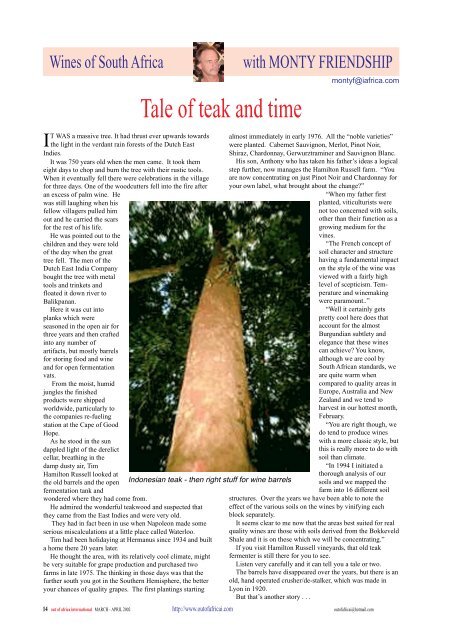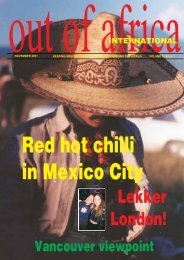Create successful ePaper yourself
Turn your PDF publications into a flip-book with our unique Google optimized e-Paper software.
Wines of South Africa with MONTY FRIENDSHIP<br />
IT WAS a massive tree. It had thrust ever upwards towards<br />
the light in the verdant rain forests of the Dutch East<br />
Indies.<br />
It was 750 years old when the men came. It took them<br />
eight days to chop and burn the tree with their rustic tools.<br />
When it eventually fell there were celebrations in the village<br />
for three days. One of the woodcutters fell into the fire after<br />
an excess of palm wine. He<br />
was still laughing when his<br />
fellow villagers pulled him<br />
out and he carried the scars<br />
for the rest of his life.<br />
He was pointed out to the<br />
children and they were told<br />
of the day when the great<br />
tree fell. <strong>The</strong> men of the<br />
Dutch East India Company<br />
bought the tree with metal<br />
tools and trinkets and<br />
floated it down river to<br />
Balikpanan.<br />
Here it was cut into<br />
planks which were<br />
seasoned in the open air for<br />
three years and then crafted<br />
into any number of<br />
artifacts, but mostly barrels<br />
for storing food and wine<br />
and for open fermentation<br />
vats.<br />
From the moist, humid<br />
jungles the finished<br />
products were shipped<br />
worldwide, particularly to<br />
the companies re-fueling<br />
station at the Cape of Good<br />
Hope.<br />
As he stood in the sun<br />
dappled light of the derelict<br />
cellar, breathing in the<br />
damp dusty air, Tim<br />
Hamilton Russell looked at<br />
the old barrels and the open<br />
fermentation tank and<br />
wondered where they had come from.<br />
He admired the wonderful teakwood and suspected that<br />
they came from the East Indies and were very old.<br />
<strong>The</strong>y had in fact been in use when Napoleon made some<br />
serious miscalculations at a little place called Waterloo.<br />
Tim had been holidaying at Hermanus since 1934 and built<br />
a home there 20 years later.<br />
He thought the area, with its relatively cool climate, might<br />
be very suitable for grape production and purchased two<br />
farms in late 1975. <strong>The</strong> thinking in those days was that the<br />
further south you got in the Southern Hemisphere, the better<br />
your chances of quality grapes. <strong>The</strong> first plantings starting<br />
Tale of teak and time<br />
Indonesian teak - then right stuff for wine barrels<br />
mailto:montyf@iafrica.com<br />
almost immediately in early 1976. All the “noble varieties”<br />
were planted. Cabernet Sauvignon, Merlot, Pinot Noir,<br />
Shiraz, Chardonnay, Gerwurztraminer and Sauvignon Blanc.<br />
His son, Anthony who has taken his father’s ideas a logical<br />
step further, now manages the Hamilton Russell farm. “You<br />
are now concentrating on just Pinot Noir and Chardonnay for<br />
your own label, what brought about the change?”<br />
“When my father first<br />
planted, viticulturists were<br />
not too concerned with soils,<br />
other than their function as a<br />
growing medium for the<br />
vines.<br />
“<strong>The</strong> French concept of<br />
soil character and structure<br />
having a fundamental impact<br />
on the style of the wine was<br />
viewed with a fairly high<br />
level of scepticism. Temperature<br />
and winemaking<br />
were paramount..”<br />
“Well it certainly gets<br />
pretty cool here does that<br />
account for the almost<br />
Burgundian subtlety and<br />
elegance that these wines<br />
can achieve? You know,<br />
although we are cool by<br />
South African standards, we<br />
are quite warm when<br />
compared to quality areas in<br />
Europe, Australia and New<br />
Zealand and we tend to<br />
harvest in our hottest month,<br />
February.<br />
“You are right though, we<br />
do tend to produce wines<br />
with a more classic style, but<br />
this is really more to do with<br />
soil than climate.<br />
“In 1994 I initiated a<br />
thorough analysis of our<br />
soils and we mapped the<br />
farm into 16 different soil<br />
structures. Over the years we have been able to note the<br />
effect of the various soils on the wines by vinifying each<br />
block separately.<br />
It seems clear to me now that the areas best suited for real<br />
quality wines are those with soils derived from the Bokkeveld<br />
Shale and it is on these which we will be concentrating.”<br />
If you visit Hamilton Russell vineyards, that old teak<br />
fermenter is still there for you to see.<br />
Listen very carefully and it can tell you a tale or two.<br />
<strong>The</strong> barrels have disappeared over the years, but there is an<br />
old, hand operated crusher/de-stalker, which was made in<br />
Lyon in 1920.<br />
But that’s another story . . .<br />
14 out of africa international MARCH - APRIL 2002 http://www.outofafricai.com mailto:outofafricai@hotmail.com



